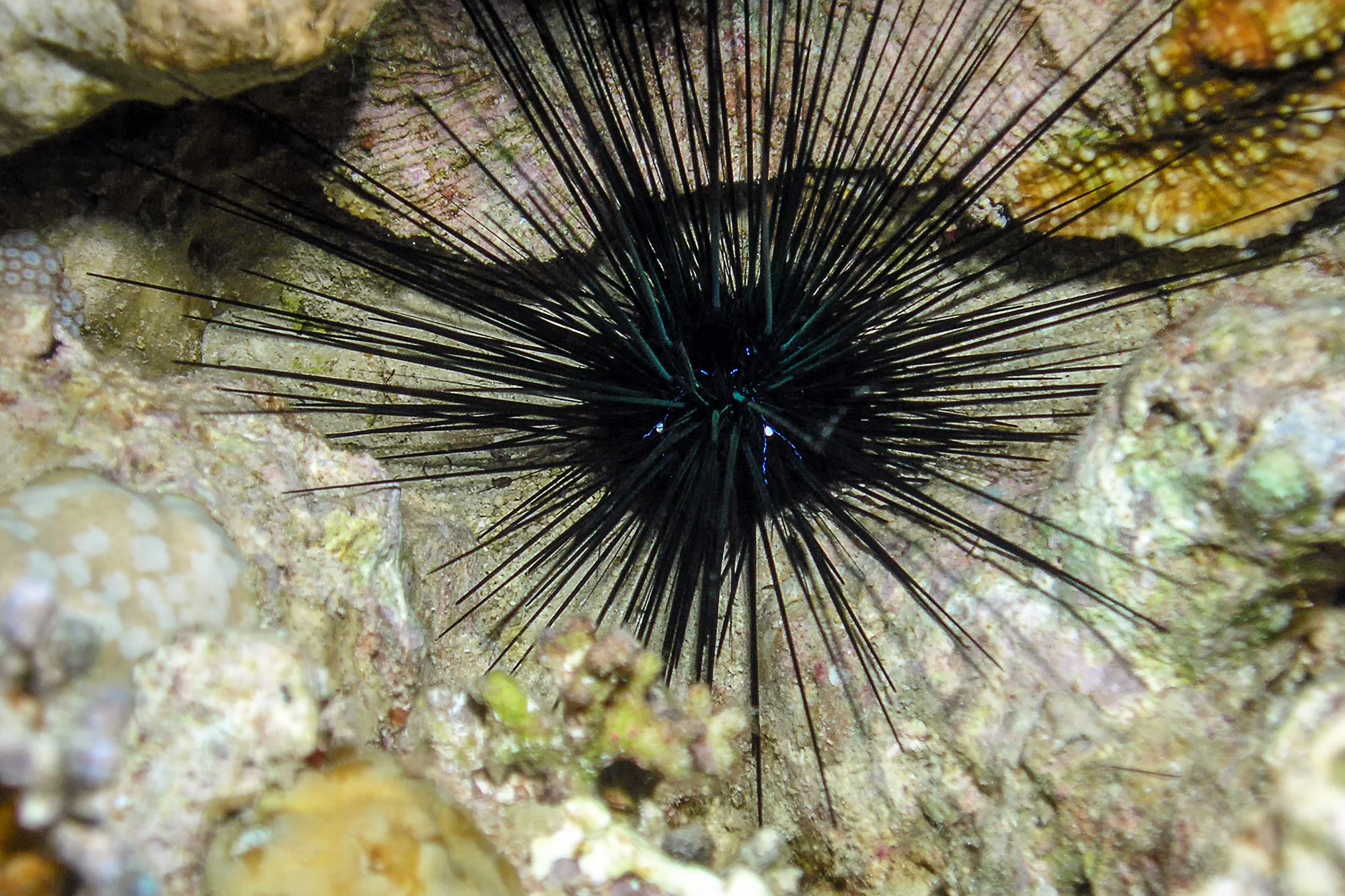Ein einzelliger Organismus, Scuticociliate, wurde als Ursache für das Massensterben von langstacheligen Seeigeln im Jahr 2022 in der Karibik und an der Ostküste Floridas identifiziert. Diese Seeigel sind für die Gesundheit von Korallenriffen unerlässlich, und die Entdeckung wirft Fragen über das Vorhandensein von Ciliaten, ihre Wachstumsbedingungen und ihre potenziellen Auswirkungen auf andere Arten auf. Foto des langen, stacheligen Seeigels (Diadema antillarum).
Das Massensterben des langstacheligen Seeigels – ein Verlust, der die Gesundheit der Korallenriffe von der Karibik bis zur Ostküste Floridas bedroht – wurde von einem einzelligen Organismus namens Ciliat verursacht.
Die Jagd nach einem Mörder endete 2022, die langstachelige Seeigel in der Karibik und entlang der Ostküste Floridas ausrottete. Ein Forscherteam, das von Mia Breitbart, Distinguished University Professor am College of Marine Sciences der University of South Florida, organisiert wurde, hat einen einzelligen Organismus namens Ciliar als Ursache für den massiven Tod eines Meerestiers identifiziert, das für die Gesundheit der Korallenriffe von entscheidender Bedeutung ist.
Ihre Ergebnisse werden am 19. April in der Zeitschrift Nature veröffentlicht
Ciliate culture viewed under the microscope. Credit: Mya Breitbart USF College of Marine Science
“We’re beyond thrilled to get to the bottom of the 2022 mystery and a bit stunned we did it so quickly,” said Breitbart, senior author on the Science Advances study and an expert in marine genomics. “We had a great team in place and the tools needed to do the ocean science equivalent of a forensic investigation.”
Ciliates are microscopic organisms covered in hair-like structures called cilia that help them move and eat. They are found almost anywhere there is water and most are not disease-causing agents. However, this specific species of ciliate – called a scuticociliate – has been implicated in die-offs of other marine species, such as sharks, in the past.

Photo compilation showing the same sea urchin before and after infection with the ciliate in the USF aquarium research facility. Credit: Makenzie Kerr USF College of Marine Science
Examining urchins collected from 23 sites in the Caribbean, the research team used a series of techniques to confirm the source of the die-off event.
After identifying the ciliate in every affected urchin specimen using genomic techniques, the team grew ciliates in the lab and performed infection experiments at the USF College of Marine Science. When the pathogen was introduced to otherwise healthy urchins in an aquarium tank, the urchins died within a few days – replicating what was taking place in the ocean and confirming the ciliate as the disease source.

DaSc-affected sea urchin, Aruba, August 2022. Credit: Ian Hewson Cornell University
“We’re excited to share this information with everyone, from reef managers to additional scientists so we can explore it further and try to stop its spread,” Breitbart said.

Mya Breitbart (USF) viewing the ciliate culture by microscopy. Credit: Makenzie Kerr USF College of Marine Science
The long-spined sea urchins inhabit shallow tropical waters and feed on algae that would otherwise destroy a reef. They began to lose their spines within days of contracting an unknown disease and died in droves starting in January 2022.
A similar die-off event took place in the early 1980s, which wiped out 98 percent of the long-spined sea urchin population. The culprit of that die-off remains a mystery.
Breitbart first got the call about the unfolding die-off at the end of March 2022. She immediately assembled a team consisting of Ian Hewson, lead author on the publication and a marine ecologist at Cornell University; Christina Kellogg, a microbiologist from the U.S. Geological Survey in St. Petersburg, Fla. who has worked extensively on coral reef diseases; and USF graduate student Isabella Ritchie.
“At the time, we didn’t know if this die-off was caused by pollution, stress, something else – we just didn’t know,” said Hewson, an expert in diseases that cause mass die-offs of sea stars, who flew from New York to the Caribbean Islands to observe the situation.
Even with the source of the mysterious die-off uncovered, questions still remain. For example:
- Is this ciliate new to the area, or was it there prior to the die-off?
- If it has been there, what environmental conditions favored its growth and why did it infect the urchins?
- Can it affect other species of urchins?
„Eine Theorie, die wir haben, ist, dass der Ciliat unter den in der Karibik beobachteten hohen Produktivitätsbedingungen gut gewachsen ist, als er zum ersten Mal zu verblassen begann“, sagte Kellogg. „Wir sind auch neugierig auf die Tatsache, dass es einige Überschneidungen in einigen der geografischen Gebiete gibt, in denen dieses Aussterben stattfand und in denen Korallenriffe aufgrund der Steinkorallen-Gewebeverlustkrankheit zurückgehen.“
Referenz: „Scuticocylate Agent Causes Mass Mortality of Diadema Antillarum in the Caribbean Sea“ von Ian Hewson, Isabella T. Ritchie, James S. Evans, Ashley Alterra, Donald Berenger, Irene Bowman, Marilyn Brandt, Kayla A. Budd und Rollo A. Camacho, Thomas O. Cornwell, Peter D. Kimani A. Kitson-Walters, Patricia Kramer, Judith C. Lang, Harilaos Lessios, Lauren Liddy, David Marancik, Stephen Nimrod, Joshua T. Patterson, Marit Pistor, Isabel C. Romero, Rita Sellares-Blasco, Moriah LB Sevier, William Sharp, Matthew Souza, Andrina Valdez-Trinidad, Maren van der Laan, Brian Villanova-Cuevas, Maria Villalpando, Sarah de Von Huene, Matthew Warham, Tom Weyers, Stacy M. Yanong, Soumira Zambrano, Alise Zimmerman, Mia Breitbart 19. April 2023 Hier erhältlich. Wissenschaft schreitet voran.
DOI: 10.1126/sciadv.adg3200
Die Forschung wurde von der National Science Foundation, dem Atkinson Rapid Response Center for Sustainable Futures, AGGRA, der National Oceanic and Atmospheric Administration, der National Fish and Wildlife Foundation, dem Florida Keys Marine Preserve und der Florida Fish and Wildlife Commission finanziert.

„Musikfan. Sehr bescheidener Entdecker. Analytiker. Reisefreak. Extremer Fernsehlehrer. Gamer.“







More Stories
Der Perseverance-Rover der NASA hat einen Stein auf dem Mars gefunden, der auf uraltes Leben hinweisen könnte
Wissenschaftler entdecken „dunklen Sauerstoff“, der in den Tiefen des Ozeans ohne Licht entsteht
In einigen Bundesstaaten könnte heute Abend das Nordlicht leuchten